The UFO Events at Minot AFB (one of the best cases ever)
A Narrative of UFO Events at Minot AFB
PART 4
Thomas Tulien
Narrative of UFO Events at Minot AFB
on 24 October 1968
Thomas Tulien
3. B-52 and the Ground Observers at N-7
As the B-52 continued its descent to
Minot AFB, the remote observers at N-7 were unaware a UFO was closely pacing
the B-52, and that the pilots had lost two-way communications with RAPCON. At
some point, the Base Operations Dispatcher informed them that a B-52 was
diverted to area, and they were directed to the precise time and location of
the incoming aircraft. O’Connor noted that, “a B-52 was sent to the area to
check out the sighting and was seen west of the object at first.”[91]
Jablonski compared the bright illumination of the UFO to the landing lights of
the approaching B-52:
As to the alternating illumination, particularly the white, it appeared as two or three automobile headlights. When the B-52 had flown in its search it had been using its landing lights which were quite similar in nature. As to avoid confusion between the plane and the object Base Ops had pointed out where and when we saw the B-52. Must add that the B-52’s engines could be easily heard while the UFO made no sounds to be heard at about the same distance. [92]
The N-7 personnel had been observing
the UFO in the southeast, but when the B-52 appeared high in the west-southwest,
the UFO descended to the horizon and was no longer observed in the area.
According to Jablonski:
Just prior to our sighting the diverted B-52 in the WSW the object had descended gradually and for 1 minute or 2 had appeared to be obstructed by trees. . . . When the B-52 flew in the vicinity (SSE) it was no longer seen in that location.[93]
It is intriguing to note, about the
same time the UFO disappeared from view southeast of N-7, another UFO, which
had been pacing the B-52 high in the northwest, also disappeared from the B-52
radarscope, just prior to emerging into view below the overcast and haze above
9,000 feet. The visibility at lower altitudes was 25 miles and clear.[94]
Dr. Claude Poher’s recent photogrammetric analysis of the B-52 radarscope
photographs proposes that the aircraft was at an altitude of 8865 feet, while
18.8 nautical miles from the runway at the time of the last radarscope photo.
This position is west-southwest of N-7, and suggests that the UFO broke off
just before the observers at N-7 first observed the B-52. In fact, the ground
observers could clearly see and hear the incoming B-52 but did not observe the
UFO pacing the aircraft.
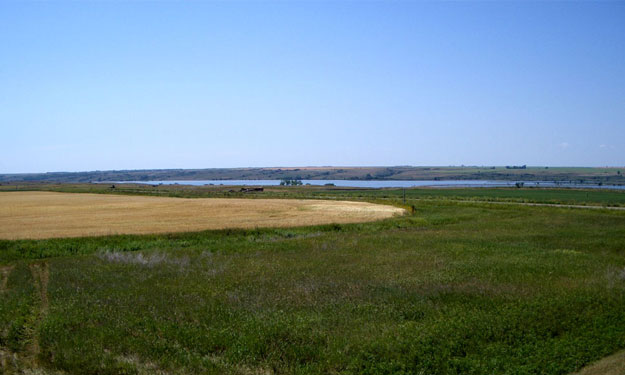
N-7 looking southwest from the front gate, with Lake
Darling, the Upper Souris National Wildlife Refuge,
and Grano Crossing in the distance. A satellite view of November-Flight
(zoom-in to view N-7 and surrounding area) is available from Wikimapia.
-------------------------------------------
Narrative of UFO Events at Minot AFB
on 24 October 1968
Thomas Tulien
4. B-52 Air-visual UFO Observations (4:24-4:28)[95]
As the B-52 passed by on its way to the base, the personnel at N-7 were no longer observing the UFO and returned to their assigned duties.[96] RAPCON cleared the incoming B-52 for low approach to the runway. By 4:06 they had completed a missed approach, and were given a vector to turn left onto the crosswind leg of the traffic pattern bearing 335 degrees, at a standard altitude of 3200 feet MSL (roughly 1500 feet above the local terrain). The controller then provided clearance for the B-52 to visually land if communications were interrupted.
04:06 ac 31 going around ct 31 roger ac Steady 335 3200 04:09 ct JAG 31 roger, radar contact this will be a vector to the precision final approach course rw [runway] 11 ac JAG 31 roger ct Jag 31 if no transmissions received for one minute in the pattern take over visually if unable cleared for approach ac Roger 31 understand ct Jag 31 turn left heading 290 maintain 3200 downwind leg[97]
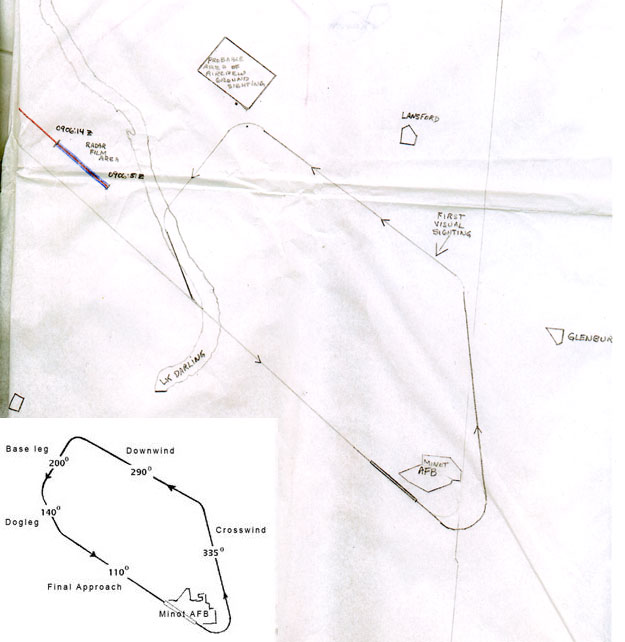
Partial scan of Werlich’s Overlay Map showing the first
circuit around the traffic pattern. Werlich did not plot the second circuit of
the traffic pattern, when the pilots observed and over flew the UFO on or near
the ground. Our reconstruction of the B-52 flight track suggests that the B-52
flew further out during the second go-around
(Werlich Overlay Map).
RAPCON continued to provide vectors, and at 4:17 the B-52 was back in line with the runway on final approach.[99]
04:13 ct JAG 31 are you observing any more UFOs? ac Negative on radar, we can’t see anything visually. ct JAG 31 roger the personnel from the missile sites advise that they don’t see anything anymore either. ac Roger ct JAG 31 turn left heading 200 maintain 3200 base leg[98]
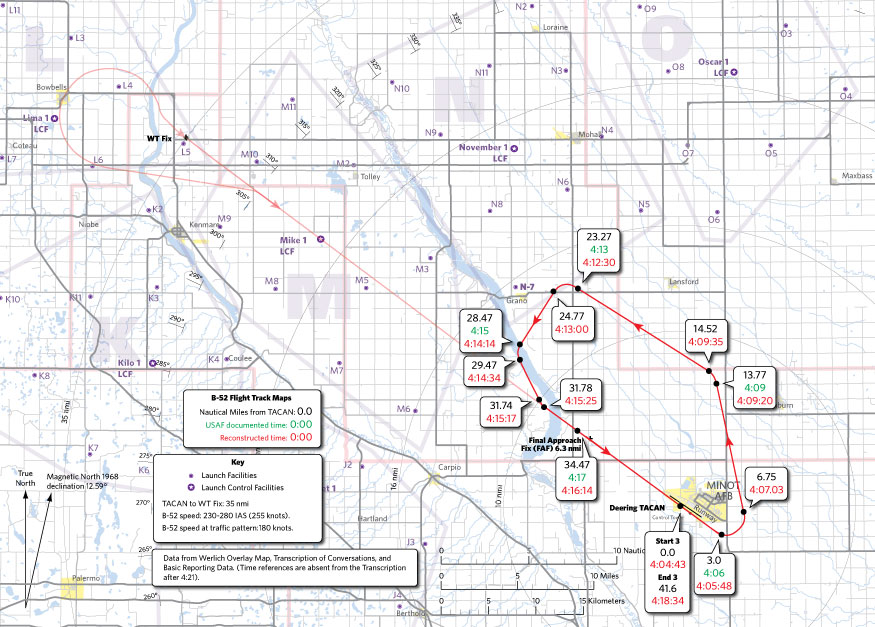
First circuit around the traffic pattern. At 4:13, at the
beginning of the turn onto the base leg, RAPCON queried the pilots whether they
were observing any more UFOs. Total flight time of the first go-around is 13:51
minutes. Detailed information regarding Minot AFB (KMIB), including an airport
diagram is available from: http://www.airnav.com/airport/KMIB.
RUNYON: The request was made after our radios came back in and before we made our low approach, which, like I said, I thought we wanted to land—but maybe even before we could tell the ground people we wanted to land someone came over the radios. He didn’t say “This is General such-and-such,” he just said, they said, “General such-and-such wants you to go back around and overfly the object.”McCaslin also recalls the conversation over the intercom:
INTERVIEWER: But, did he come over the radio?
RUNYON: It’s possible I don’t know, he could have—they could have patched him in—he could have been at SAC Headquarters, or it could have been Tom Goduto on the HF radio, because he would have been in contact with higher headquarters through that radio. But basically someone told us to go back around and the ground controllers knew that—well, I don’t know they could hear—but they knew we were supposed to go back and overfly the thing. [101]
McCASLIN: There was a request for us to go around one more time visually, and see if we could see something. I do not remember the exact words but the pilots were not keen to do that, but agreed to do it on the condition that they were going to come around one time visually and then were putting it on the ground and full stop.[102]Frankly, McCaslin was hoping that the pilots would decline the request:
McCASLIN: I can remember that conversation. They wanted us to go around and do a visual and our pilot was reluctant to do that, but he agreed to go around and take a look. That to me was the tensest part of it, going over this thing at low altitude, basically on a search mission at a low altitude, and I remember that being a pretty tense time. I even remember him saying “We’ll go around one time and then we’re putting this thing on the ground,” because everybody had had about enough of it.[103]Thus it appears a General was in contact with somebody at Minot AFB, and concurrently monitoring the events. Further, it is clear the General and RAPCON knew the precise location of the UFO at rest, on or near the ground. None of the ground observers reported the UFO in this general location, and the source of this information is not evident in the documentation, except for a notation by the Wing Security controller stating, “the approximate grid coordinate of the apparent landing was at AA-43.”[104] This location is just over 2 miles north-northeast of N-7; adjacent to the “probable area of aircrew ground sighting” indicated on Werlich’s overlay map.[105]
At 4:21, Runyon requested vectors back around the traffic pattern for an Instrument Flight Rules (IFR) surveillance approach, which would take them once again around the traffic pattern to a terminal landing (full stop) at 4:40.
After executing another missed approach to the runway, the B-52 pilots were provided the first vector for the crosswind leg of the traffic pattern.
04:21 ac Approach control this is 31 ct JAG 31 this is Minot approach control go ahead ac I’d like to get a vector around for an IFR, surveillance approach. Like to touch down at 40 past. ct Roger you want full stop at 40 ac Affirm be termination[106]
After 4:21, the time-code references for the remaining entries are absent from the commmunications transcript. In addition, the next vector for the 290-degree downwind leg of the traffic pattern, and apparently, any communications during the downwind leg are also absent. RAPCON should have provided the 290-degree vector just prior to the pilots initial air-visual observation of the UFO on the ground ahead of the aircraft. Runyon recalls:
04:21[+] ct Jag 31 roger turn left heading 335 maintain 3200 this will be a vector to the surveillance final approach course rw11 usable length 13,200, descent to minimum descent altitude will be authorized 5 miles from rw ac 31 roger ct Lost communications remain the same do you wish any portion repeated ac Negative 31 ct 31 roger ct (garbled) ac 31 roger ct JAG 31 (garbled) requests that somebody from your aircraft stop in at basops after you land ac Roger 31 we’ll give them a call[107]
RUNYON: [The RAPCON controllers] gave us a heading to fly back over the object, and when we made our go-around over the runway, made our turn and headed back, just as soon as we rolled out at wings level there was an orange glow sitting out there, almost off our nose about 11:30 position, just a little bit to the left side of the airplane, so we were heading towards it, straight to it.During the official investigation, none of the regular B-52 crewmembers were interviewed, including Runyon or Aircraft Commander Cagle. The only air-visual description of the object is provided by the non-crew pilot Major Partin in his AF-117, from the initial position of observation (first visual sighting) “northeast of Minot AFB, N.D., 10 miles at an altitude of 3200 feet MSL.” He noted the time and duration from 4:30 to 4:35 as determined by the pilot chronometer.[109] As seen through the windshield, he described an “unusually bright light I had never seen at night in this area,” which was below the horizon in the west-northwest (292 degrees), and looked like “a miniature sun placed on the ground below the aircraft.”[110]
INTERVIEWER: Do you remember talking about it with Partin?
RUNYON: No, I just don’t remember. I got busy with checklists and fuels and things like that. And you know, just as soon as I got everything caught up, I looked up and we were on top of it.[108]
As I turned on to [the] downwind leg in the traffic pattern, I saw a bright orange ball of light at my one o’clock position. It appeared to be about 15 miles away and either on the ground or slightly above the ground. The light remained stationary as we flew toward it. I turned onto the base leg about one mile to the south of the light and was above it. The light did not move during this time.[111]In his AF-117, Partin neglects to recount the earlier air-radar encounter, and the descriptions of the air-visual observation seem rather perfunctory. In a January 2001 interview he recalled some additional details:
PARTIN: We were on a crew mission and back in the local area at Minot. We were about ready to make our penetration and low approach, and I guess we were in the neighborhood of 20,000 feet probably [when] the radar called and said he had a return off the left wing and did I see anything? I looked up there and didn’t see anything. . . . All of a sudden, he said “God Almighty!” and I said “What’s wrong?” He was alarmed, you know, and he said that whatever that was took off to our left at a tremendous rate of speed, he couldn’t even measure it.During the final go-around of the traffic pattern, the conversations in the communications transcript lack any reference whatsoever to the pilots air-visual observations and overflight of the UFO, suggesting that the completion of the flight was routine and uneventful. This was certainly not the case according to Runyon and his fellow crewmembers. Nonetheless, Werlich furnished the following remarks in the comment section of the Basic Reporting Data.
INTERVIEWER: Is he seeing this on the radarscope?
PARTIN: Yeah, he watched it go. So we forgot it and went on down and were shooting low approaches in the traffic pattern. Somewhere in the process, I changed seats got into the co-pilot’s seat. I don’t remember doing that but I remember looking off to my right probably about the 2 o’clock position as they used to say, and low, and I saw a—it was sort of oblong, there were, looked like windows around it that were lit and it was just hovering there. . . .
INTERVIEWER: This was a visual pass, the last one?
PARTIN: Yeah, I don’t know if it was—you could see houses on the ground from that altitude, and they looked like, you know, about the size of dice—a die.
INTERVIEWER: Maybe like a Monopoly house?
PARTIN: Yeah, right and this was much larger than that. [112]
REMAINING AT RADAR TRAFFIC PATTERN (3200 FEET MSL) THE AIRCRAFT COMPLETED ONE GCA [Ground Controlled Approach] AND MISSED APPROACH AND WAS ON A HEADING OF 335 DEGREES FOR A RADAR VECTOR TO THE GCA DOWNWIN[D] LEG WHEN THE INSTRUCTOR PILOT, SITTING IN THE RIGHT SEAT, VISUALLY SIGHTED AN OBJECT AHEAD AND BELOW. AS THE AIRCRAFT APPROACHED TO WITHIN APPROXIMATELY 2 MILES, THE OBJECT SEEMED TO REMAIN STATIONARY AND CLOSE TO THE GROUND. VISIBILITY WAS REPORTED AS 25 MILES AT THAT ALTITUDE. THE AIRCRAFT TURNED ONTO THE BASE LEG, LOST SIGHT OF THE OBJECT AND CONTINUED WITH A GCA AND TERMINAL LANDING.[113]In fact, immediately after the B-52 turned onto the 290-degree downwind leg, both pilots observed the large, bright orange ball of light ahead in the distance. Over the next few minutes, Runyon had his head down in the cockpit occupied with routine tasks, running the numerous checklists, and checking fuel settings in preparation for landing.[114] Eventually, out of the corner of his eye, his attention was drawn to something on the left side of the aircraft.
RUNYON: When I first looked up we were already beside it, and so I didn’t look straight ahead out my window, but I looked out the pilot’s window, and there was something that to me—. Well, the first thing I saw was a dark square, a rectangle and then this red, a dull red around it. I mean, it wasn’t well lit, it would blend in with the ground pretty well, or the night sky, but this one part—one shadow was completely black and my eyes were drawn to it.
I was thinking “Well that’s a barn loft and the door’s open where they put hay in the thing,” but I wasn’t thinking that a barn was not going to be that high, because I’m really not looking down, I’m looking out, maybe down some to the side. My concentration was on that dark spot at first. So we’re flying beside the object and I take my eye away from that—there was really nothing to see just this dull-reddish and I didn’t see the bottom, and I didn’t see the top. I’m just looking along the side and it might be my field of view was limited looking across the airplane.
So then, we come to a metallic cylinder, sort of like stainless steel or shiny aluminum protruding from the end of this thing, and it’s on the ground and the ground is just well lighted here. I could see maybe trees, bushes, or breaks in the ground; I could see different things on the ground. And as we are going past this, I looked back and I thought that this thing might be pretty close to the first big part of the object, but it appeared to be attached, and it was coming out of the end of it, and that end was well-lit, and well, it was sort of barn red but it was lighter—a whole lot brighter than it was down the sides from the glow of the next section, which was like a crescent moon—a crescent-shaped object attached to the other end of the cylinder.
The light illuminating from it had the cylinder completely illuminated just about as if it was daylight, really. The crescent-shaped part appeared to be solid but [also] appeared to be translucent, like you could almost see through it, it was solid, the lines were distinct on it, and it was higher than the tube section was—not a whole lot higher, but it wasn’t nearly as high as the main body of the thing was.
As we banked over it to make our crosswind, I guess we were told to turn about that time, and our radios went out again because I did transmit something and they did not receive. And as we went by, it was pretty good size because that is all that really showed up—or maybe I was just concentrating on it and didn’t see anything else—but at one point I could see it and the tubular section and the front part of the main body together.[115]

Capt. Bradford Runyon’s drawing of the UFO following our
initial interview. He cautiously estimated the size as 200 feet in length; 100
feet in width; and 50 feet in height. At 3200 MSL, their altitude would have
been around 1500 feet above the local terrain.
RUNYON: We are level and we don’t bank until we get right to the end of it. Major Partin started his turn just as we got abreast of the end of it, and turned almost over the top of the thing. I’m sure we were told to turn by the ground controllers, so they knew exactly where we were in relation to it.[116]His attention was ultimately drawn to the source of the bright lights emanating from the backside of the crescent-shaped section, attached to the end of the main body by a shiny cylinder.[117]
RUNYON: And the object we saw on the ground, it wasn’t—well, it was different types of material. It wasn’t just a big ball of glowing anything; it had different features to it.Once again, when the B-52 was in close proximity to the UFO the radios lost the ability to transmit to the ground controllers.
INTERVIEWER: Any other colors?
RUNYON: The part I thought was the cabin, the control center, so forth—now it had colors inside it. I mean the colors I saw really weren’t on the outside; they were back inside. . . . I tried looking in there, but I could not—I could see some lights, and it seems to me like I can remember green and yellow, but I just don’t know. I thought I should be able to see objects in there, [but] we went over real fast and I really could not distinguish anything inside.
INTERVIEWER: You assumed there was something inside?
RUNYON: Well, I just assumed there was something in there because I could see lights, and it looked like I could see back inside for part of the front view of it.[118]
RUNYON: Well, anyway our radios went out again and I was talking to the ground controllers, and they said—of course every time the radios went out they thought we had a problem, or something—they mentioned that our radios went dead in mid-word, not mid-sentence, just the word broke off. . . . The controllers were asking me if we had it and so forth. I'm talking to them. After we went back and turned towards the runway again the radios came back in. Of course they had me change and try different frequencies, but there wasn't anything wrong with the radios. So we were instructed to send one of the crewmembers to tell someone about what we had observed. Since Major Partin [was] a little bit more senior than I was, he went in to tell what he had seen and I have no idea what he said. We never discussed it afterwards.[119]Though navigator McCaslin was down in the belly of the aircraft during this time, he recalls the pilot’s amazement on viewing the object close up.
Apprehensive, McCaslin declined an invitation to come upstairs to view the object.McCASLIN: The first time I was aware that the pilots saw anything was after that low approach, when we came back and were basically bombing the position, and when they—there was an expletive from the top, they started describing this thing and asking if I wanted to come up and see it. After the fact, when we were talking in the debriefing, and as we were taxiing in and all that, everybody agreed it was pretty spectacular.
INTERVIEWER: Did he describe it to you?
McCASLIN: I don't remember if it was Brad or one of the other pilots. The description to me was this: that it was an elliptical shape, kind of a cough drop-shaped thing, glowing orange with a boomerang exhaust, or boomerang-shaped exhaust, or whatever—a fluorescence off one end the same color, and that’s all I remember of the description.[120]
McCASLIN: I tried to put myself in the position of whatever this thing was; and now you’re going to have an eight-engine bomber fly over you at a very low altitude. I mean these guys that were asking me to come up and take a look were in ejection seats.
INTERVIEWER: You were scared?
McCASLIN: Let’s say prudent. Now, I’ve been very afraid in airplanes, and I don’t remember being afraid. I knew there was something going on that wasn’t normal, and I knew that in situations like that you want to give yourself every chance to survive in it. You know, in retrospect I wish I’d seen the thing visually.
INTERVIEWER: Anything stopping you?
McCASLIN: No, I was being invited up to take a look, which I would have had to unstrap, climb up the stairs, go up front, stand there between the pilots to look—completely unstrapped to anything, no parachute, nothing. To quote our former 41st President, “Didn’t seem prudent.” So I stayed where I was.[121]
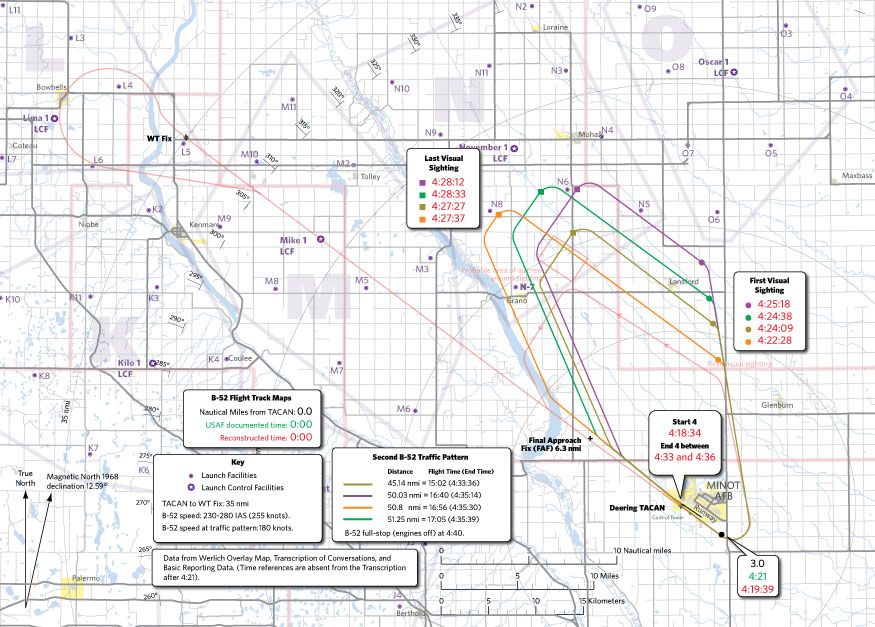
Second circuit of the traffic pattern. Since time
references are missing in the communications transcript following 4:21,
we have plotted several possible patterns that would bring the B-52 to a
full stop (parked with engines off) at 4:40. Total flight time is
between 15:02 and 17:05 minutes, which is an additional 1-3 minutes
compared to the first go-around, indicating that the B-52 flew further
out to the north and/or west during the second go-around. At 4:26, at
the same time the B-52 pilots were observing a stationary UFO ahead of
the aircraft, the Base Operations Dispatcher noted an object ostensibly
reported by Bond “direct S/W of N-1 moving north then lights went
out” (0828).
At some point, the crewmembers were instructed to return to base later that morning for a debriefing in the office of Brig. General Ralph Holland, commander of the 810th Strategic Aerospace Division. But in the meantime, while Cagle hurried off to Atlanta, the rest of the crewmembers headed home to bed. McCaslin reminisced:
McCASLIN: All of us were tired. We were beat. We’d been at it all day and we were ready to go home, and I remember going home and telling my wife—Sammy, she still tells me this—I woke her up and said, “You’re never going to believe what I saw tonight,” and I told her all about it, what I remembered of it, and then I went to sleep. I was bushed, and she was up the rest of the night looking out, wondering what’s out there and everything.[125]--------------------------------


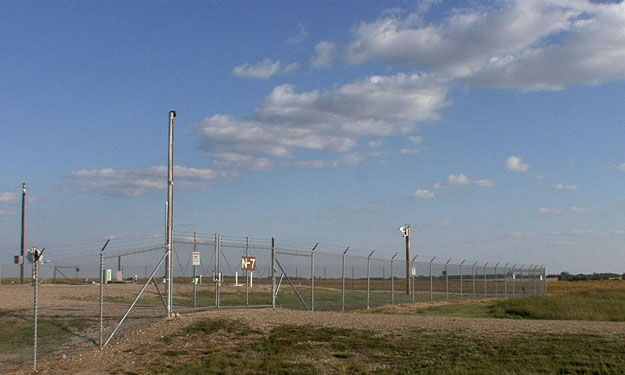
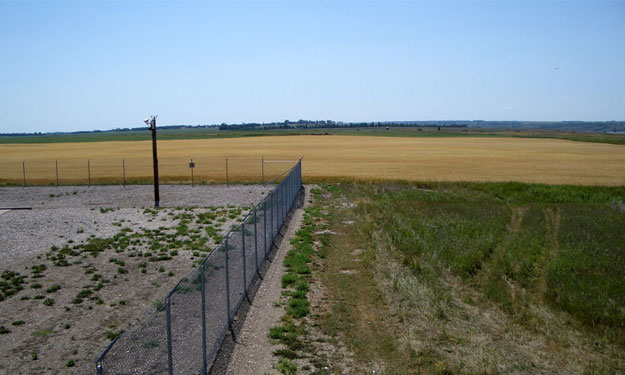
No comments:
Post a Comment